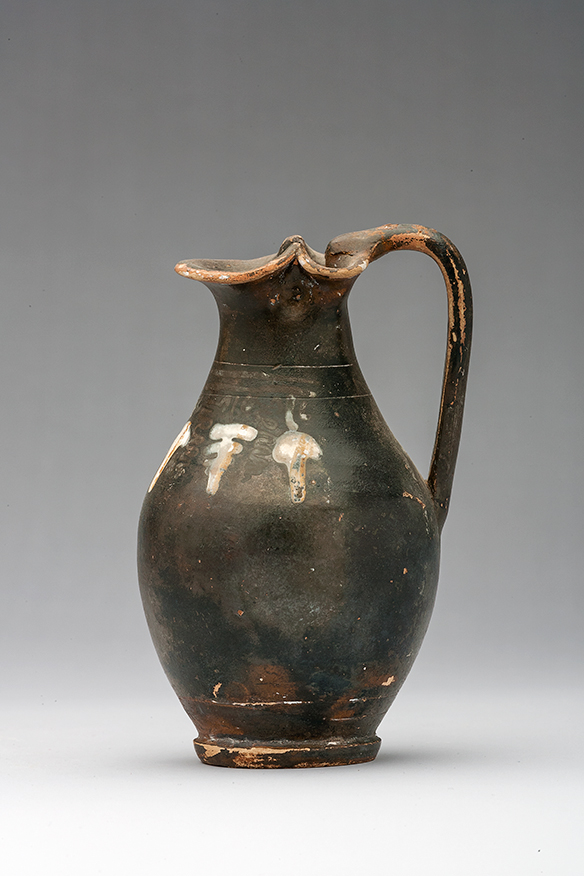Acquisition number: 1971.01
Intact but the surface is somewhat worn. Cream buff clay with traces of a more orange clay wash over. The black glaze is somewhat misfired in places; it was applied by dipping the vase in a bowl of glaze as the fingermarks about the base of the vase make clear. There are dribbles of black inside the vase, but no consistent wash. The underside is reserved and reddened. On the neck, vine pattern in added white with the right halves of the leaves and grape bunches washed over yellow.
Title: Small Gnathia Oinochoe - 1971.01
Acquisition number: 1971.01
Author or editor: J.R. Green
Culture or period: Apulian.
Date: Perhaps soon after 300 BC.
Material: Clay - Terracotta
Object type: Oenochoe
Dimensions: 60mm (w) × 107mm (h)
Origin region or location: Italy
Origin city: Apulia.
Display case or on loan: 8
Keywords: Apulian, Gnathia, Black Glaze
Folio Fine Art Ltd (London), Catalogue 77 (November 1970) no. 723 (ill.); J.R. Green with B. Rawson, Catalogue of Antiquities in the Australian National University, A.N.U. (Canberra, 1981) 66.
1971.01
Small Gnathia Oinochoe
Purchased. Ht 10.7cm; diam. 6cm.
Intact but the surface is somewhat worn. Cream buff clay with traces of a more orange clay wash over. The black glaze is somewhat misfired in places; it was applied by dipping the vase in a bowl of glaze as the fingermarks about the base of the vase make clear. There are dribbles of black inside the vase, but no consistent wash. The underside is reserved and reddened. On the neck, vine pattern in added white with the right halves of the leaves and grape bunches washed over yellow.
Apulian Gnathia; perhaps soon after 300 BC.
Gnathia pottery (so named because many of the early finds of this material were made at Egnazia in Apulia) is typified by the use of applied colour over the black glaze. The technique was introduced about 370-360 BC in Taranto and became increasingly popular during the latter part of the fourth century. As a mainstream style of decoration it seems to have largely died out in southern Apulia ca 270 BC. In other areas of Italy and Sicily it continued later (as did very simplified versions in Taranto). There is a useful general survey by L. Forti, La ceramica di Gnathia (Naples 1965). Webster (Bulletin of the Institute of Classical Studies 15, 1968, 1-33) and Green (Bulletin of the Institute of Classical Studies 15, 1968, 34-50 and Bulletin of the Institute of Classical Studies 18, 1971, 30-38) have attempted a more refined classification based on the identification of painters and workshops; see also the brief analysis and survey by J.R. Green, Gnathia Pottery in the Akademisches Kunstmuseum Bonn (Mainz 1976) together with a somewhat revised survey in M.E. Mayo and K.A. Hamma (eds.), Art of South Italy. Vases from South Italy (Exhib.Cat. Richmond, Virgina, 1982) pp. 252-259. For a survey of the various fabrics of Gnathia pottery, see Green, “Gnathia and Other Overpainted Wares of Italy and Sicily - A Survey”, in: P. Lévêque & J.-P. Morel (eds.), Céramiques hellénistiques et romaines, iii (Paris 2001) 57-103.
While the simpler types of vine pattern are often to be placed in the later part of the fourth century, the evidence of tomb-groups suggests that this particular class of jug is to be placed somewhat later. The technique of making a vase of pale clay and then covering it with a solution of orange clay is to be found on some Apulian red-figure vases and a considerable number of Gnathia: see Green, Archäologischer Anzeiger 1977, 559ff., fabric type III.
Folio Fine Art Ltd (London), Catalogue 77 (November 1970) no. 723 (ill.); J.R. Green with B. Rawson, Catalogue of Antiquities in the Australian National University, A.N.U. (Canberra, 1981) 66.
